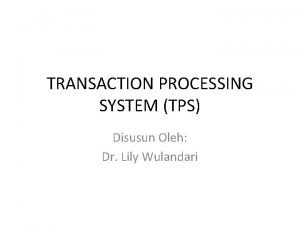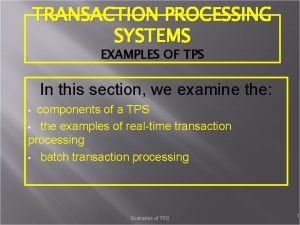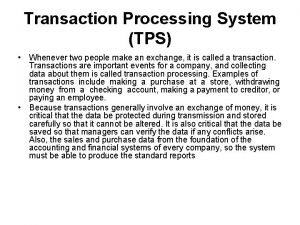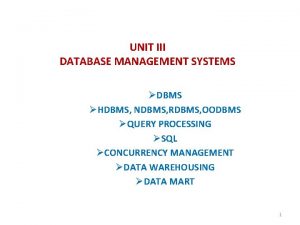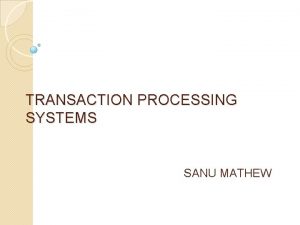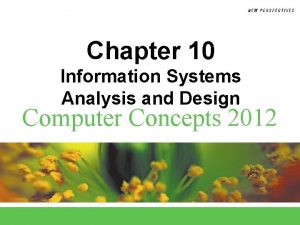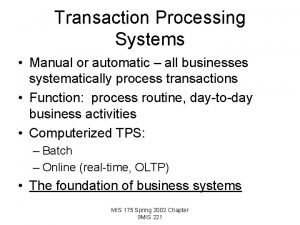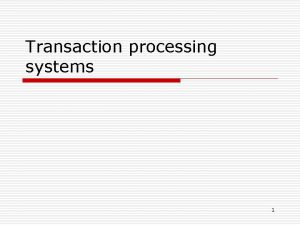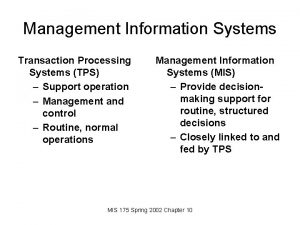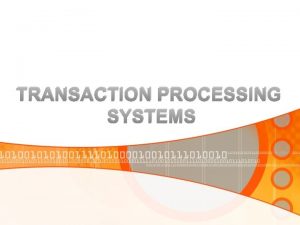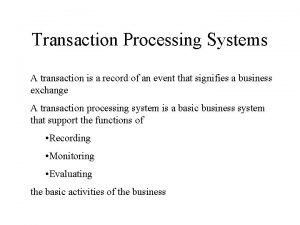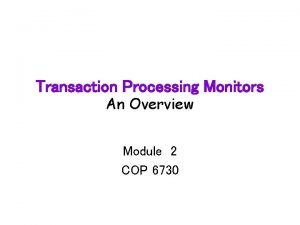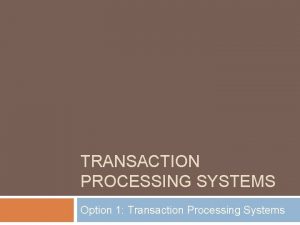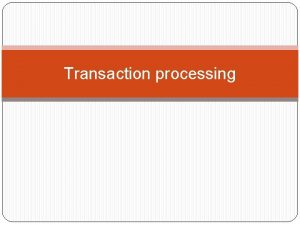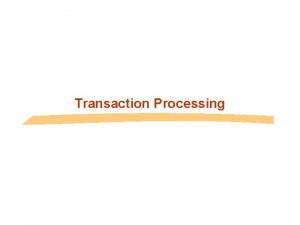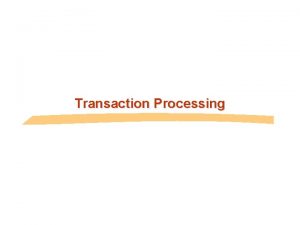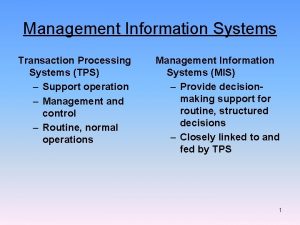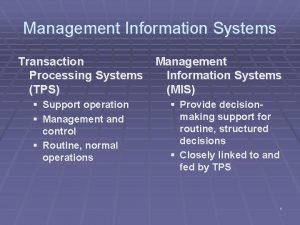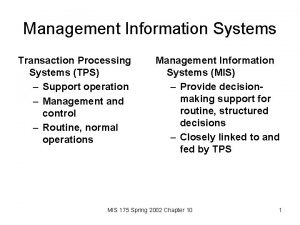TRANSACTION PROCESSING SYSTEMS Characteristics of TPS A TPS












- Slides: 12

TRANSACTION PROCESSING SYSTEMS Characteristics of TPS A TPS is the normal operation of an organisation. Includes: 1. orders 2. sales taxes 3. purchasing 4. manufacturing 5. wages 6. hiring employees 7. ware house storage distribution Characteristics of TPS 1

Characteristics of TPS Transaction Processing Systems: record and manage all this data A transaction is the process of changing or creating data. Characteristics of TPS 2

Characteristics of TPS Rapid response- customers cannot wait for a TPS to respond. Speed from input to output must be in a few seconds. Reliability- Breakdown will disrupt or stop business. Failure rate must be low. Quick and accurate recovery. Backup and recovery procedures are essential. Inflexibility- Every transaction to be processed in the same way. Operation must be standardized. Controlled processing- must support the business operations. A TPS should enforce and maintain roles and responsibilities of an organisation. Characteristics of TPS 3

Advantages of a computer-based transaction over a manual system. Manual transaction systems are business systems that operate without the use of machines Larger numbers of transactions can be processed in a shorter amount of time: cheque processing. Greater reliability. –Less prone to human error – data is much more reliable Increased storage capacity and greater ease of retrieval of stored data. More efficient in terms of space and much more reliable. Paper records deteriorate over time digital data does not. Retrieval and sorting of data is more efficient than manual methods Characteristics of TPS 4

Transaction processing is easily computerised as it is based on clear set of rules A manual POS system has 11 operational steps 1. 2. 3. 4. 5. 6. 7. 8. 9. 10. 11. Examine the product and determine the price. Record the product price on sale slip and add it to the total price of product. Repeat steps 1 and 2 for subsequent products. Check the total price of all products. Informs customer of total price and wait for payment. Receive payment. Calculate the change owing to customer. Give customer: products, copy of sales slip and change. Repeat steps 1 to 8 for next customer. At the end of day: add total sales slips = money collected Do a stocktake to count all products remaining. Characteristics of TPS 5

Two types of transaction processing Batch and Real-time Batch processing Collects data as a group/batch and processes it later. It has a time delay Processing occurs at a convenient time: during evening when PC is idle. Processing cost are lower per transaction Processing occurs without human interaction Data errors will stop a batch process E. g. Payroll, cheques, billing for electricity, E-way and telephone. The only feasible form of processing when data was stored on punch cards or tapes. Real- time processing The instant process of data- not delayed. Does not require access to an online database. Involves using a network to link terminal to mainframe. Involves a large number of users. E. g Airline reservation, banking transaction systems, library system, student enrolment systems Characteristics of TPS 6

Two main concerns with real-time processing Concurrency Two user cannot change the same data at the same time. One user cannot change a piece of data before another user has finished with it. Atomicity Ensures that all of the steps involved in a transaction are completed successfully as a group If any steps fails, no other step should be completed. Characteristics of TPS 7

Real-time transaction processing A Transaction processing monitor (TP monitor) is software that allows the transaction processing application programs to run efficiently. Terminal • It manages the sequence of events that are part of a transaction • It provides a standard interface between the input devices(terminals), the TP application programs, and the DBMS • It also provides data security User Interface • It is used in conjunction with a operating system. TP Monitor Application DBMS Database Characteristics of TPS 8

Differences between real-time and batch processing Each transaction in real-time is unique. Transaction are stand-alone both in the entry to the system and also in the handling of output. Real-time processing requires the master file to be available more often than batch processing The DB is not accessible all of the time for batch processing. Real-time processing has fewer errors than batch processing: data is validated and entered immediately. With batch, data is organised and stored before the master file is updated. Errors can stop processing Infrequent errors may occur in real-time processing. Errors are tolerated. More operators required in real-time processing-operators are not centralised. Difficult to maintain real-time system than batch processing system. Characteristics of TPS 9

Data validation is used to check the entry of transaction data. It involves transaction initiation and field checking. Transaction initiation is used to acknowledge that the TP monitor is ready to receive the transaction data. It is used in real-time processing to eliminate errors. Field checking occurs when the transaction data is entered into the database: (files, records, fields and characters). Data validation is carried out by checking the fields, using a range check, list check, type check or check digit. Data validation in real - time systems allows corrections to be made as the data is entered. It is impossible to validate all data in a TPS Characteristics of TPS 10

Historical significance of TPS Transaction processing was the first type of information system. Much of modern data processing is still based on traditional pre- computing methods Clerk manual systems include: 1. 2. 3. • • • 4. Gathering data on paper application forms Transferring the data to their own system for storage. Storing data in records in sequence. Transcribing information to invoices, orders and accounts. Updating records with addition, deletions and editing. The first commercially available electronic computer was called UNIVAC (Universal Automatic Computer) Characteristics of TPS 11

The end of characteristics of TPS Outcomes After studying this unit, you should be able to: Describe the historical importance of transaction processing. Identify types of transaction processing. Investigate data validation. Characteristics of TPS 12
 Apa itu transaction processing system
Apa itu transaction processing system Tps in it
Tps in it What is transaction processing system
What is transaction processing system Hdbms and ndbms
Hdbms and ndbms Payroll tps
Payroll tps Transaction processing systems
Transaction processing systems Manual transaction processing system
Manual transaction processing system Transaction processing system characteristics
Transaction processing system characteristics Tps information system
Tps information system Types of tps system
Types of tps system Transaction processing system
Transaction processing system Transaction processing system
Transaction processing system Transaction processing monitor
Transaction processing monitor
